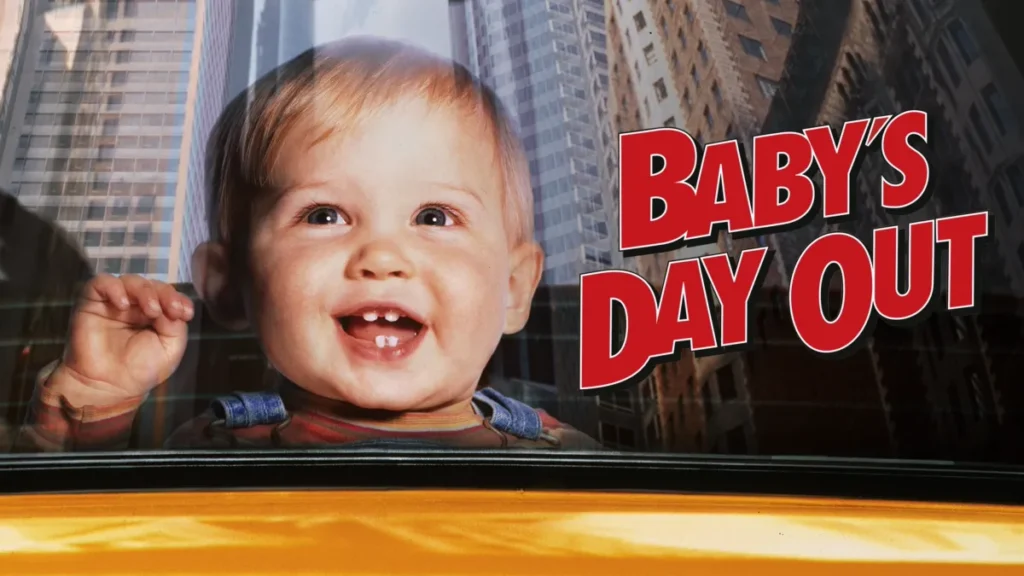
Baby’s Day Out
“Baby’s Day Out” seems like a live action comedy built from the same stuff as the Baby Herman sequence at the start of “Who Framed Roger Rabbit.” It demonstrates that what is funny in animation does not always translate into real life. When Baby Herman went fearlessly crawling on top of the refrigerator, I laughed; but when Baby Bink crawled under a taxi and out into traffic, I did not.
The film is a strange blend of 1930s images of crooks and society people, crossed with modern locations, mostly in Chicago. Three would-be kidnappers pose as baby photographers to gain entry to the mansion of the millionaire Cotwells, where Baby Bink is about to have his portrait taken. The leader of the gang (Joe Mantegna) talks Mrs. Cotwell (Lara Flynn Boyle) and the nanny and butler out of the room, then he and his sidekicks (Joe Pantoliano and Brian Haley) escape with the infant.
That’s it for plot. Most of what follows consists of cartoon-style sight gags, as Baby Bink (played by twins Adam and Jacob Worton) fecklessly crawls through the city on an odyssey inspired by his favorite story book. While all adults (except for the kidnappers) somehow never see him, Bink crawls on high rooftops, boards a bus, takes a cab, visits Marshall Field’s and goes to the zoo, where he is embraced by a protective gorilla.
Before long we’ve even been treated to that venerable cartoon gag in which Bink crawls out on an I-beam high in the air at a construction site. And when one of the bad guys hits ground level a little later on this movie invariably makes him generate a dust cloud exactly like Wile E. Coyote.
If its action is inspired by cartoons then its three Stooges are inspired by the Three Stooges. They’re not really evil, of course, just stupid and incompetent; they allow the kid to crawl out of captivity and then somehow can’t recapture him even though he is usually in sight.
John Hughes, who produced and wrote “Baby’s Day Out,” and Patrick Read Johnson, who directed it, are counting on one of the basic gimmicks of animated humor: Physical pain doesn’t really hurt. Characters can get slammed flat as a pancake but they pick themselves up, dust themselves off and start all over again. The joy in physical pain here, inflicted mostly on the crooks, reflects the same comic taste that shaped the treatment of the burglars in Hughes’ “Home Alone” movies.
A closer look at cartoons reveals that little time elapses between pain and payoff. One of the worst sequences in “Baby’s Day Out” involves Mantegna hiding the kid under a coat on his lap while two cops question him. Baby Bink finds Mantegna’s lighter, snaps it on and sets his crotch on fire. The hidden fire lasts forever, it seems, while Mantegna’s face tries to mask the pain. Then the cops leave, Mantegna leaps up, his pants burst into flame and one of his pals saves him by stamping out the fire – grinding his heel into burning crotch ,of course-. I found this sequence agonizing but I did not think it was funny
Humor is a peculiar thing. It generally thrives on pain and ridicule, but it must be careful. ‘Baby’s Day Out’ has gags that could have been successful in a Baby Herman cartoon, but in live action with real people, real buses and taxis and streets and babies they just don’t work.
The Worton twins are very cute as Baby Bink, though; there was an audible coo from the audience the first time they saw him on the screen. Unfortunately for us, the more they like him crawling around on a ledge is inversely proportionate to how much they’re going to like him.
Watch Baby’s Day Out For Free On Gomovies.
.jpg?w=1024&resize=1024,1024&ssl=1)
.jpg?w=1024&resize=1024,1024&ssl=1)
.jpg?w=1024&resize=1024,1024&ssl=1)
.jpg?w=1024&resize=1024,1024&ssl=1)
.webp?w=1024&resize=1024,1024&ssl=1)
.jpg?w=1024&resize=1024,1024&ssl=1)
.jpg?w=1024&resize=1024,1024&ssl=1)
.jpg?w=1024&resize=1024,1024&ssl=1)